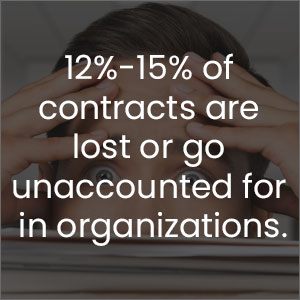“In the U.S., contract disputes represent 64% of cases in state courts.” (Gartner, June 2019).
This opening statement isn’t that big of a surprise anymore. Earlier research by Aberdeen Group pinned it at 60% of litigation’s resulting from contract disagreements. With every organization managing thousands of active contract documents, it isn’t a surprise that the majority of a legal team’s time is focused on contract disputes. 
Yet, what is surprising is that over 70% of medium and large companies have manual contract processes. Part of their contract lifecycle management (CLM) includes printing the documents, listing them on an excel spreadsheet, and stuffing them into a filing cabinet. Now, it is safe and secure. Never to be looked at again. Done! Adopting end-to-end CLM technology helps alleviate some of the legal team’s pressures.
Wait! That’s NOT a good end-to-end contract management solution! True, it provides for a contract repository. Yet, this is hardly a management system worth noting. So, here are 4 core reasons why you need an end-to-end CLM:
WHY DO YOU NEED AN END-TO-END CLM?
1. SQUEEZE CONTRACTING TIMELINES
One of the most common sales complaints about legal teams is the amount of time it takes to get a contract drafted, reviewed, and signed off. Of course, the office of the general counsel’s first priority is to manage the risks an organization takes on. However, timely turnarounds on standard items is an important step forward.
But, as Richard Susskind stated in his book ‘Evolution of Legal Service,’ it is important to understand and embrace change. A part of the digital transformation journey for corporate legal teams is stepping from the bespoke (completely customized), through to the standardization phase, and finally, to the systematization phase as shown below.

Speed-Up Options
Whether sales sided or not, adopting end-to-end CLM technology helps reduce pressure on the legal team. Contract drafting (authoring) can be sped-up with templates and pre-approved clauses (terms & conditions). In other words, the system gives you contract assembly.
This means that the general counsel does NOT have to be involved in the day to day details of the ‘standard stuff’. In this case, a legal professional other than the general counsel can create that first draft.
Then, of course, there is a controlled negotiation cycle, common approval workflow, and an industry-standard integrated electronic signature system. Integrated together, all of these parts let the legal counsel focus on more strategic matters. These systematic details addressed by the legal operations team. Therefore, it speeds up contract completions, without compromising on quality.
2. COMPLIANCE: REDUCING YOUR RISK
The importance of an end-to-end CLM is the fact that all aspects of your agreements are in one place. Aberdeen Group’s research also showed that “12% – 15% of contracts are lost or go unaccounted for in organizations.” This is a huge risk burden to carry. You just know that inevitably the contract that ends in dispute is the one that disappeared.
But, it goes beyond merely having the standard single contract repository. It is also about auditing, analyzing, and having a pulse of your agreements as a whole. Today’s end-to-end contract management includes artificial intelligence (AI) to provide real-time audit trails and contract snapshots.
This lifts the burden of tedium from the legal team. In other words, it gives the team the ability to quickly find outliers. They can immediately spot risky clauses (i.e. limitless liability), and improve compliance consistency, too. After all, the digital transformation journey is about improving the consistency and quality of your contracts. Ultimately, this helps your team reduce the overall organizational risks taken with new agreements.
Not Just Sell-Side or Buy-Side
Related to compliance and consistency is the importance of stepping away from the old ways of looking at contracts. For instance, older contracting systems were designed expressly for procurement (buy-side) or for sales (sell-side). However, modern end-to-end CLM’s need to go beyond that. Compliance here is about the ability to span all contracts. In doing so, assess for risks, and manage the agreements equally well across the board.
This includes supporting:
- Procurement: buy-sided contracts, purchase master agreements
- Sales: SLAs (service level agreements), SOW (statements of work), NDA (non-disclosure agreements), sales agreements, partnership pacts, strategic alliance accords, and master agreements

- IT: Vendors deals, SaaS, SLAs, volume discount agreements, and service contracts
- Human Resources: non-compete | non-poaching clauses, options deals, intellectual property, and employment contracts
- Facilities: lease arrangements, maintenance agreements
- Marketing: tradeshow, lead generation, advertising, and brand representation contracts
Certainly, this list is not exhaustive. There are other areas in an organization that also sign agreements. Similarly, these need to be included in the end-to-end CLM considerations and contracting process as well. A big part of it is keeping up the company’s compliance standards across so many different accords.
3. CONTROL YOUR PROCESS
End-to-end contract lifecycle management is about control. Specifically, it is about controlling your contract management process. It establishes enterprise-wide approval workflows. Also, it sets up methods to request, generate, negotiate, analyze, sign, and manage your company’s agreements. In other words, an end-to-end CLM gives you a pulse on your whole contracting ecosystem.
Good end-to-end CLM’s don’t cut you short at the contract authoring, agreement repository, or analytics phase. First, it takes you from the beginning of receiving the request to help you draft the agreement. Second, it makes sure you have the approved clauses for your T&Cs which helps with the contract negotiation. Third, it captures the electronic signature (sign-off) and collects all documents into a single repository. Finally, it gives you post-award capabilities. These being running audit trails, searches, AI-driven analytics, and full retrievals – when needed.
Ultimately, an end-to-end CLM is a powerful solution. It puts the power of the full contract set in the hands of the General Counsel and legal operations team.
4. GIVES YOU AI-ANALYTICAL FEEDBACK
Looking back to the opening quote from Gartner – that 64% of a company disputes are due to contracts – there is no doubt that audits, analysis, and maintaining control are key. In short, a critical part of a modern end-to-end CLM is AI-driven analytics.
Having so many active contracts within a mid to large organization means they can be hidden in many different places. It is important to work with vendors that help make this digital transformation onboarding easy. In doing so, the AI engines need to be seamlessly integrated into the solutions. That makes it easy to use, intuitive and lets users get the most out of the contract repository. AI-driven analytics provides contract managers with a real-time pulse on the contracts the business uses.
CONNECT WITH US TO LEARN MORE
Although contract management is extremely important to modern business, it is not always easy. Even less, are the agreement solutions on the market, and those that claim to be true end-to-end CLM’s. Remember that ContractPodAi is always interested in helping you better understand the system that will help you deliver on all these needs. Connect with us for a pressure-free discussion about your contract management software needs, challenges, and the solutions that are available to overcome these pains. And, let us show you how a true end-to-end CLM can help.
Author:

Sarvarth Misra
Connect with us on Linkedin


